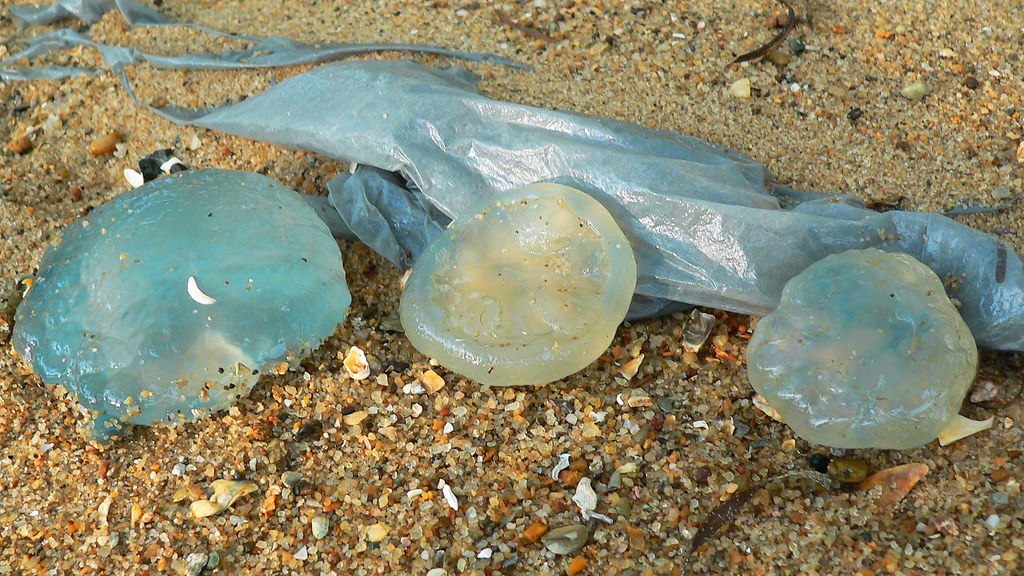24
Plastics are an integral part of our modern lives. They are found everywhere from Home Goods to electronics, and are by far one of the most versatile and useful technologies humans have been able to harness. On top of their usefulness, plastics are easily re-purposed, with more than 40% of plastic being recycled. Although plastic helps us go about our everyday lives, it is having a serious effect on the ocean and marine life. In 1975 it was reported by the National Academy of Sciences that an estimated 14 billion pounds of garbage, much of it plastic, were being dumped into the oceans every year. Today, that number has shrunk to around 8 billion pounds a year thanks to public awareness.
So what are the effects plastic has on marine life?
For starters, ”…Plastic has been found in more than 60% of all seabirds and in 100% of sea turtle species…” according to the group Ocean Conservancy To a sea turtle, a plastic bag can look extremely similar to a jellyfish, which is a common food source for them. For other species such as seabirds, fish are a common food source. When smaller pieces of plastic get consumed by small fish, the plastic will move its way up the food chain to bigger fish and bigger fish until it is consumed by a seabird, or other marine animal. The accumulation of plastic in these species impacts their health in many ways including nutrient uptake, general fitness, and feeding efficiency.

While fish and turtles are motile animals, sessile species such as corals are not free from the effects of plastics in their environment either. A study has been done by Hall et al. that shows corals will consume micro-plastics at the same rate as their food. Micro-plastics are any piece of plastic under 5mm in size. The corals in this study were found to starve at a very slow rate because the plastic pieces that they were consuming overloaded their stomach and they were not getting the amount of nutrients that they needed. Corals are very non-selective feeders, but they are sensitive to their environment.
Although the oceans are huge, they are not big enough to disperse all of the plastic that winds up in them. It is estimated that there are between 15-51 trillion pieces of plastic in the worlds oceans, and due to ocean currents, millions of tons of plastics congregate in massive gyres in the ocean. There are 5 major subtropical gyres, each containing its own garbage patch. The most notorious of these is the Great Pacific Garbage Patch, an island of plastic waste 1.6 million kilometers squared in area, or three times the size of France. In this garbage patch, it is estimated that there is 6 times more plastic than plankton. Plankton is a necessary food source for some marine life. It is also up to 9 feet deep in some portions of the garbage patch. For more information on garbage patches, watch the video below:

One of the questions this raises is how does it all get there? How does 8 million tons of plastic waste end up in the ocean each year? In the developed world, which contributes for roughly 10% of the worlds plastics problem, plastic enters our oceans through our sewer systems, and as consequences of storms and heavy rains. While the developed world contributes in part to the plastic problem, we are by no means the biggest culprit. According to the World Economic Forum, 90% of all plastic waste that pollutes our oceans comes directly from 10 rivers in China, Southeast Asia (Laos, Thailand, Vietnam, etc), Egypt, and Niger. What these areas have in common are massive populations centered around these rivers combined with poor waste management systems and general lack of education about environmental preservation.

So what is being done to combat this?
There have been a number of laws put in place in an attempt to stop the plastic pollution. The Act to Prevent Pollution from Ships (APPS) (PDF) was amended in 1987 by the Marine Plastic Pollution Research and Control Act. It is meant to reduce the amount of improperly disposed plastic that is released into the environment. It also studies the effects that this plastic is having on the environment.
The Marine Debris Research, Prevention, and Reduction Act (MDRPRA) (PDF) has established programs within the National Oceanic and Atmospheric Administration (NOAA) and the United States Coast Guard. Its goal is also to reduce the amount of plastic and trash that gets put into the marine environment.
The Shore Protection Act (SPA) is another Act that was put into place in order to stop this growing problem. This Act controls the transportation of waste in coastal waters.
One of the most important Acts put into place is the Marine Protection, Research, and Sanctuaries Act (MPRSA). It is also known as the Ocean Dumping Act and it prohibits the following:
- Transporting material from the United States with the intention of ocean dumping
- Transporting material from anywhere for the purpose of ocean dumping by U.S agencies or U.S flagged ships
- The dumping of material transported from outside the U.S into the U.S. territorial sea
Outside of the US, thanks to efforts by international and local organizations, agreements have been signed and efforts are being made to reduce plastic wastes across the globe. China for example has ordered 46 cities to recycle 35% of all plastics by the year 2020, and India has begun to ban disposable plastics in some cities.
The information in this chapter in thanks to content contributions from Andrew Fuhs and Alana Olendorf
